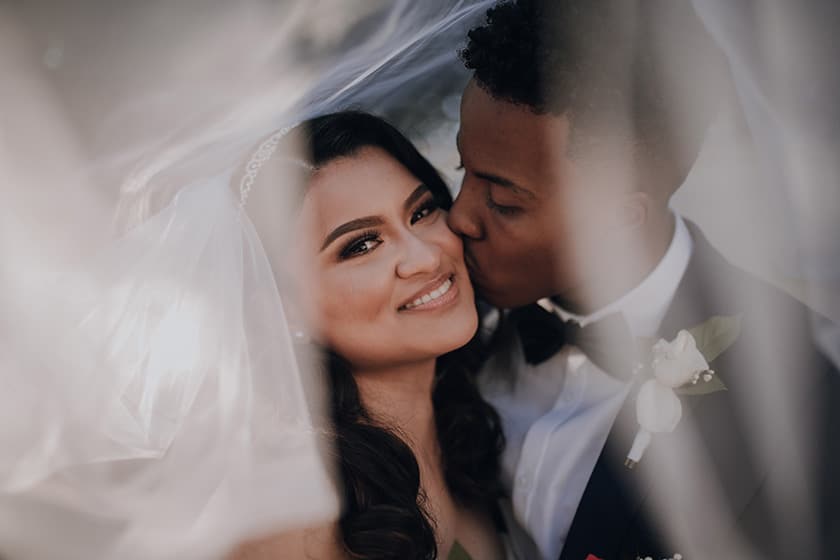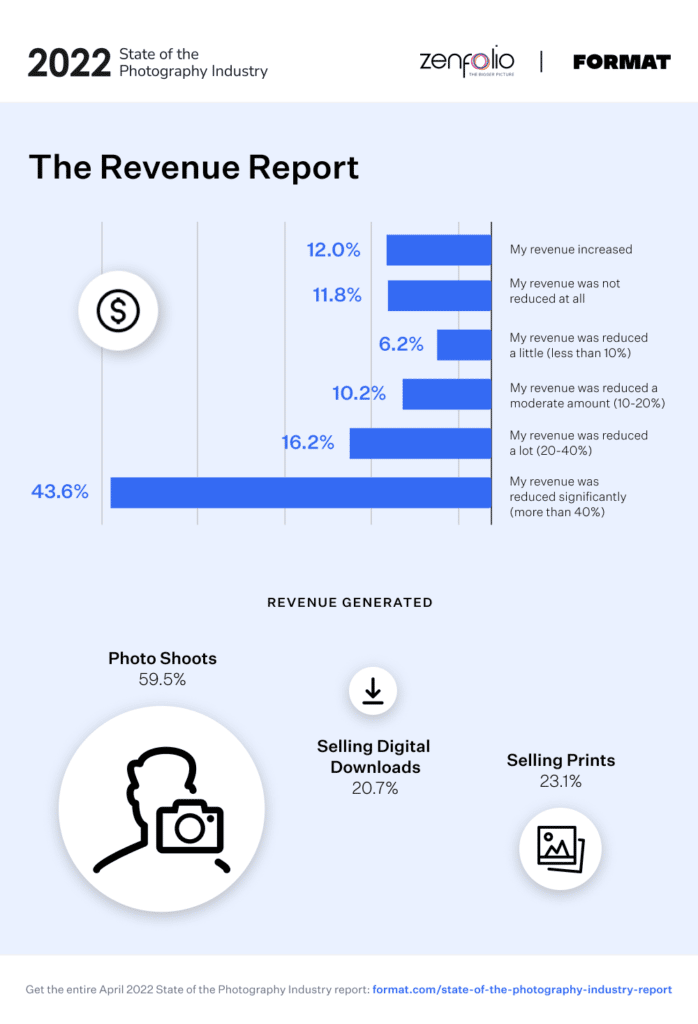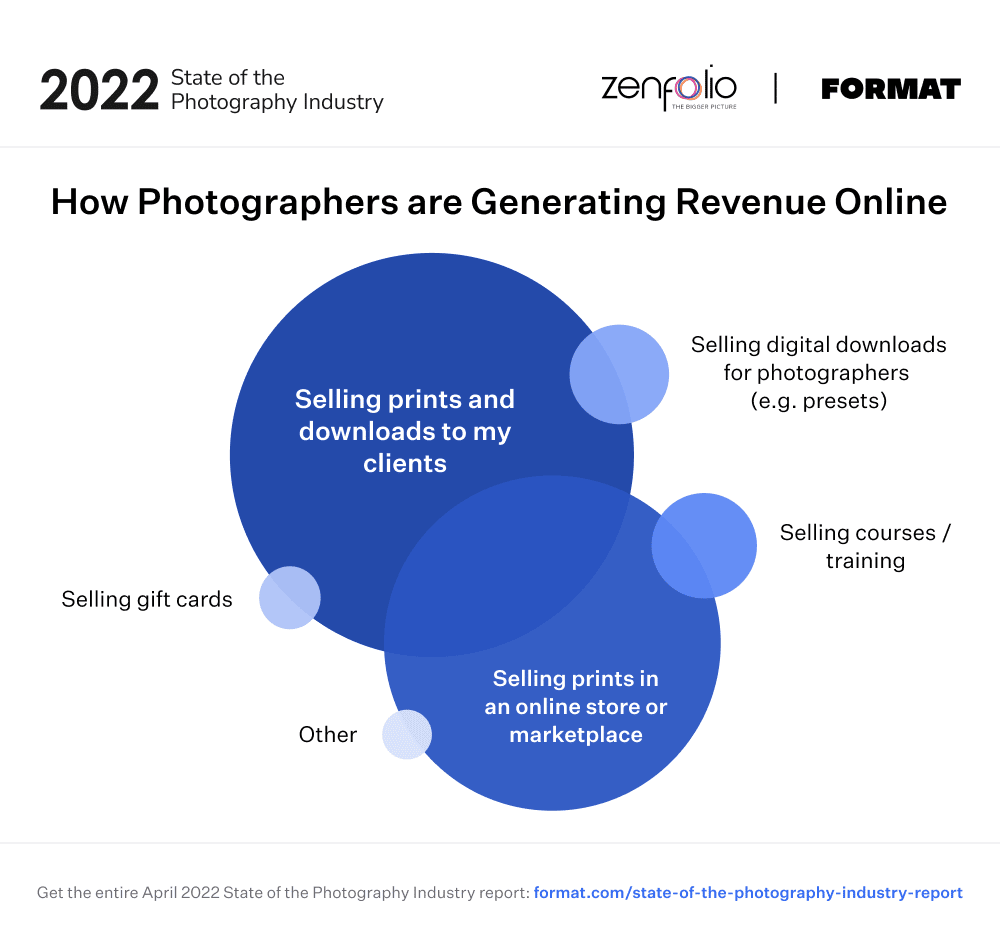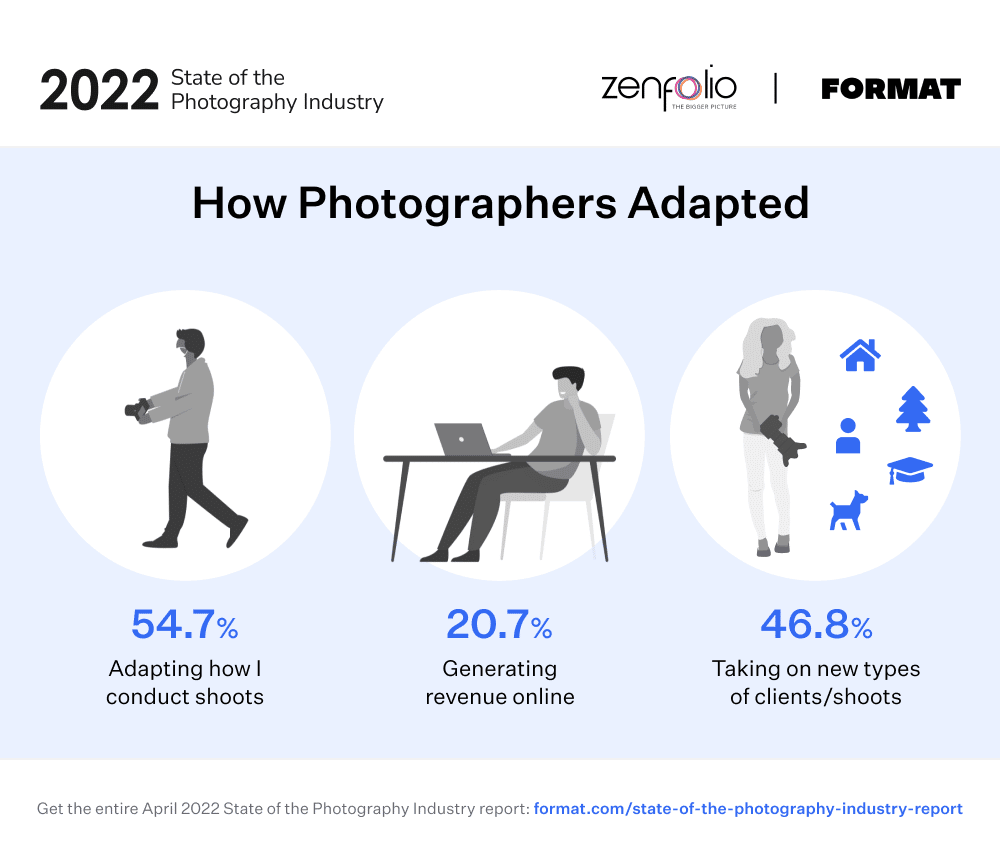How are photographers diversifying their income in a post-COVID world?
June 22nd, 2022
If there’s one lesson that we can pick out from the very dark time that was the COVID-19 pandemic, it would be this: If you want to make money as a photographer, it’s more important than ever to have a digital presence.
As we all know, COVID was detrimental to many individuals, families, and small businesses. It forced people to put events on hold, it pressured companies to lay off employees, and it made the public even more particular about how and with whom they spent their time.
As with most job positions that weren’t deemed “essential”, but that required in-person interaction, photographers took a big hit to their bookings, and ultimately, to their paychecks.
In fact, according to data that we gathered in the State of the Photography Industry Report, 43.6% of photographers reported their revenue reduced significantly (more than 40%), with another 16.2% stating their revenue was reduced a lot (20-40%).

While we hope to never experience another pandemic again, COVID has made it very clear that we can’t predict the future and we always need to be prepared for what challenges could arise. In other words, being prepared is critical if you want to maintain a consistent cash flow as a photographer. Part of being prepared is having the right tools at your disposal to keep you profitable. That’s where Zenfolio can help.
We surveyed 3400 photographers around the globe to understand how they were affected, and what they did to stay afloat during COVID. In this article, we’re going to break down some of those ideas from photographers about how you can maintain your income during trying times like COVID, including how to price your work, trends in the industry that are worth paying attention to, and new tactics for selling your work for all different verticals.
How are photographers making money during COVID?
Photographers are making money during COVID by:
- Selling prints online
- Selling digital downloads
- Creating stock imagery
- Teaching photography online
- Working from home (i.e. home studio)
- Booking clients with social distancing measures in place
- Booking in advance
- Selling Photoshop actions
- Selling Lightroom presets
- Offering editing services
- Trying virtual photography sessions
- Considering full-time employment

When in-person shooting and sales become next to impossible, how can photographers make money? We’re going to go in-depth into all of these different ideas for you today. We’ll divide the ideas up into SELLING and PHOTO SESSIONS, which you’ll see listed out for you below.
If one of these ideas sticks out to you, be sure to continue reading for more in-depth tips and tricks.
Selling Prints, Selling Digital Downloads, and more!
Photographers are accustomed to selling their prints, but with COVID, in-person selling strategies became much more complicated. For some, introducing a new digital way of selling was enough, but others needed to combine selling strategies in order to meet their income goals.
Regardless of whether its in-person or digital, selling prints is a strategy that any photographer can implement. Even if you are a photographer who relies heavily on close contact in-person photo sessions, like wedding, family, or portrait photography, you can incorporate new selling strategies into your workflow.
Similarly, for photographers who specialized in more independent styles of photography like wildlife photography or landscape photography, but who relied on in-person sales to make money, you’ll still find that you’re able to make money during COVID with these new ways of selling.
Also, keep in mind that according to our State of Photography Industry Report, digital downloads actually beat out in-person photography sales in 2021, indicating to us that there is plenty of opportunity for digital sales in photography. It’s time to make use of them.
Here are some of our favorite ways to make money selling as a photographer during COVID:
1. Sell prints online.
If you’re not selling your prints online already, now is definitely the time to start. Online sales allow you to have a business that operates 24/7, 7 days/week, without you having to physically be present.
Online sales allow you to reach audiences near and far. And, most importantly, online sales allow your photography business to keep running safely and effectively even when COVID measures come into effect.
Zenfolio members benefit from the inclusion of selling and eCommerce features as part of their membership and Format members can list their products on the Prints Marketplace. Both of these platforms let you list your images for purchase while the platform takes care of everything from payment processing to order fulfillment with our professional print lab partners.
2. Sell digital downloads.
Once you’ve set up an online store with your prints, it’s also worth considering setting up an option for digital downloads of your work.
A digital download gives a customer permission to download your photo(s) at a set price, and then print the image at a local print shop.
Not only does this save you time, energy, and money because you don’t have to physically pack the order yourself (if you’re not using Zenfolio or Format 🤔), but it also gives your customer another option for buying (an option that is oftentimes more affordable for the average consumer).
After photo sessions, selling digital downloads and prints online were two of the most profitable ways photographers made money during COVID.
3. Sell stock imagery.
If you’re a photographer who has been in the business for a long time, there’s a good chance you have hundreds of images that you’ve never used. If this is the case, why not put some of these images to use by selling them on stock imagery websites?
You probably won’t make a fortune doing this, but it’s an excellent way to make use of photos that you already have that aren’t serving you.
With that in mind, even if you don’t already have stock images, if you’re looking for a way to sell your work to a customer base with needs, stock photography is an excellent option for making money that won’t be impacted by COVID. Stock imagery is an excellent passive revenue stream for photographers.
4. Sell photography courses.
Revenue generated from selling courses and workshops was still relatively low in comparison to selling digital downloads and prints online, but it was still one method that photographers used for supplementing their income during COVID.
For some, this meant selling a self-paced course for other aspiring photographers. For others, it meant selling an ebook full of photography tips and tricks. There were even virtual workshop events where photographers could share their expertise with fellow photographers. The educational space is growing quickly in the creative community as more and more new creatives are trying to get the best information to help make their fledgling businesses viable.
5. Sell Photoshop actions/Lightroom presets.
If none of the above ideas caught your attention, photographers can also leverage their editing experience and create Photoshop actions, Lightroom presets, or both!
Photoshop actions are a series of procedures that allow a photo to be edited in a particular manner. Actions can be for anything from automatically resizing images to a specific format, to applying color corrections, to teeth whitening. Create useful and interesting actions that other photographers can purchase and use to save themselves time in their editing workflow.
Lightroom presets are custom edits that change the overall appearance of your photos with a one-click solution. You can apply a preset to an entire photoset to achieve a consistent look instead of editing each individual image and potentially having aesthetic differences from one photo to the next. Of course you can make smaller tweaks to an image once the preset is applied to get it right where you want it. Presets also save editing time and make it easy for young photographers to get started with a specific style early in their creative journey.
Presets have become very popular for photographers who are looking to replicate the look of other image-makers they admire. It gives you access to a lot of creative variety when choosing which preset works best for a particular photo or series.
In both cases, you can apply the action or the preset to multiple images making them very sellable.
In fact, according to our report, Instagram was the top marketing tool for photographers during COVID. This matters because Instagram is a platform where it is easy to market presets since many users are looking to give their images a cohesive and branded look.
If you’re a photographer using Instagram, try selling presets, and see how much income you can generate.
6. Sell editing services.
In a similar vein, you can also offer your photography editing skills as a service.
While this wasn’t reported as an income stream for photographers during COVID, it’s worth considering taking your photography skills and applying them in a different way.
You can do this for a company that requires touch-up edits for their website, or maybe a model who wants to retouch her images. Whatever the case, when photography jobs are hard to come by, don’t forget that you also have skills in editing.
7. Sell in-person.
While digital downloads and selling prints online generated more income for photographers in 2021, according to our State of Photography Industry Report, photographers were still making money with in-person sales.
How?
It’s important to keep in mind that not every in-person sales opportunity was shut down because of COVID. Some photographers traveled to events where there were fewer restrictions, some sold locally in small boutiques, and some simply sold to friends and family.
While everyone’s comfort level with in-person sales will be different, there were opportunities to sell photography in person while still practicing social distancing and wearing a mask.
Photo Sessions and working as a photographer during COVID.
Despite COVID, 60% of respondents from our State of Photography Industry Report indicated that they generated the majority of their revenue from photo sessions and fees associated with the session. This might seem surprising considering in-person sessions became much more challenging due to canceled events and social distancing.

Having said that, just because respondents said they made most of their income through photo sessions does not mean they were necessarily making the same amount of money as they were prior to COVID. In fact, as stated earlier, 43.6% of respondents said that their income was reduced significantly because of COVID.
With that in mind, here are some of the ways that photographers were making money with photo sessions during COVID, and some new ideas for making money from photo sessions that maybe you hadn’t considered.
1. Home Studio
Not every style of photography is going to be able to make use of this idea. For example, you can’t do wedding photography with a home studio, and it obviously doesn’t make sense to set up a home studio for landscape photography.
A home studio works best for:
- Product photography
- Food photography
- Portrait photography (self-portraits)
- Stock photography
In other words, if it’s a small item that you can photograph yourself, having a home studio can come in handy during COVID.
2. Social Distancing.
Can you book photo sessions and still practice social distancing? Absolutely!
With 60% of respondents reporting that they made most of their income through photo sessions during COVID, it’s clear that some photographers were doing their best to carry on with business as normal (with all precautions and distancing in place, of course).
Respondents also reported that only 55% changed the way they conducted photoshoots due to COVID. While 55% is still over half of the respondents, it means that 45% of respondents didn’t have to change how they conducted photoshoots during COVID.
Some examples of measures taken by photographers to continue to shoot while restrictions were in place, was to move the shoot outside in a well-ventilated area and using a longer focal length lens so the photographer could keep a safe distance from the subject.
COVID Restrictions by Country.
It’s also important to keep in mind that different parts of the world handled COVID differently. For example, photographers reported business being significantly slower than expected in the Netherlands, while business in Spain was reported as about the same as expected.
Looking specifically at the U.S., photographers in Ohio, Pennsylvania, Wisconsin, and Kansas reported business feeling normal (and in some cases, busier than normal). On the other hand, Tennessee, Maryland, North Carolina, and New Jersey reported business feeling slower than expected.
All of this to say, while some photographers struggled to make money from booking photo sessions, others were able to go on in a relatively normal way.
3. Virtual Sessions.
Keeping in mind that 45% of respondents had to change how they conducted photo sessions during COVID, the two most notable changes made were obvious: mask-wearing and social distancing.
In other cases when restrictions were stronger and/or there were other circumstances that made in-person sessions difficult or next to impossible, some photographers got creative and made use of virtual sessions.
This means that you (the photographer) had to virtually coach another person on how to do your job over a video call, directing the pose, lighting, and framing, while the person operating the camera would simply press the shutter. For example, a virtual session could have worked in a newborn photography setting, where you would coach new parents through taking professional-level photos of their newborn.
Another type of remote session that was trending at the peak of lockdown was a photographer and client working together on a video call. The photographer would direct the client on where to stand, how to pose, how to manipulate the light, etc… in the video frame. Then the photographer would take a photo of the screen they are using for the call, take a screenshot, or grab stills from a recording of the call.
Of course, this isn’t the ideal way to take photos, but COVID challenged photographers to think out of the box with new ways to make money when they weren’t able to be physically present.
4. Advanced Booking.
While much of the world might have gone on pause during COVID, people still continued living their lives as normally as possible. This means couples still got engaged, babies were born, pets were adopted, and restaurants were opened.
What does this mean for photographers? It means that even if something like a wedding was delayed during COVID, the couple would still require a photographer for their rescheduled wedding.
With that in mind, photographers could book clients well in advance, allowing the photographer to secure some type of deposit from the client so they had income to keep them afloat until the actual day of the wedding.
Having said that, wedding photography was reported as one of the busiest types of photography in 2021 likely due to pent-up demand from 2020, meaning even if you struggled to get wedding clients in 2020, you likely didn’t struggle nearly as much in 2021.
While this method works well for weddings due to their somewhat flexible dates, booking in advance wouldn’t work well for types like newborn and maternity photography.
Family, portrait, event, and travel photography are other shoot types that would benefit the most from advanced booking.
5. Full-time Employment.
It’s no secret that being self-employed is hard work; even at the best of times! Being a self-employed photographer can have a lot of benefits, but during COVID, as the data in our report has shown, many photographers have found self-employment quite challenging. Namely because with self-employment comes less job security. To put a number to that, 40% of full-time self-employed photographers lost 43% of their revenue, while nearly half of part-time self-employed photographers reported losing more than 40%.
On the other hand, as a full-time employee at a studio, agency, etc, unless the company had to make the decision to close its doors, you were able to maintain your job as a photographer.
According to our survey, full-time employed photographers were impacted the least by COVID with the largest proportion of respondents saying COVID had little or no impact on their work.
All of this to say, while there certainly are benefits to being self-employed, if job security and consistent revenue are priorities for you, working as a photographer within an established company might be an option worth considering for you.
How to calculate photography pricing during COVID.
Pricing your photography appropriately during COVID is an important piece of the puzzle to make money during this time. Price too high and the general public (who are also quite possibly also tightening their belts) won’t be able to purchase your photos/services. Price too low and you’re going to be overworking yourself and not make any profit.
Here are our best tips for pricing during COVID:
- Ensure that your pricing reflects the value you provide. You might be tempted to raise your rates to offset the slower business during challenging times, but if your work doesn’t reflect such a high price tag, this won’t bode well for future bookings.
- If you want to charge more, provide more services (i.e. make extra packages with upgrades available.)
- During stressful times like COVID, it’s even more important to stay connected to the photography community. Ask other photographers how they’re adjusting pricing and adjust accordingly (you want to be somewhere in the middle ideally.)
- If you’re struggling to keep up with bookings, it might be time to raise your rates. For instance, since wedding photography was so popular in 2021, if you’ve booked 3-4 clients quickly, you might find that by the 4-5th booking, it might be appropriate to raise your rates to keep up with demand. Remember, you can only take on so much.
- If you’re finding that people are turning you down because of your high rates, it might be time to reconsider your rates, or add value or services in order to bring your services up to the level you’re charging.
- You don’t want to lose the clients you already have scheduled. Even if events get canceled, maintain good relations with your clients and don’t change prices on them. One caveat to that would be if your material costs increase (i.e. if you shoot film and film prices have gone up.) If you do need to increase prices, always communicate with your clients and be fully transparent as to why there is a necessary price increase.
- Be sure that you have very clear refund policies in place.
New business trends in photography you need to know.
After a difficult couple of years that challenged photographers, we are happy to report that 89% of photographers are feeling optimistic about the future of photography.
Undeniably, though, COVID has changed how photographers do business, which reflects in the business trends we’re now seeing.
Some of these new photography trends include:
1. More outdoor and nature photography.
With things starting to open back up, we’re seeing more indoor photography, but because of COVID restrictions, we definitely saw a trend of more outdoor and nature photography in 2021.
Even today, with fewer restrictions, outdoor weddings, concerts, events, and celebrations are still preferred over large indoor gatherings. Because of this, outdoor photography has become popular.
In fact, landscape photography was the second most popular photography vertical shown during our survey (11.4%).
2. Raw realism.
Photography was definitely not the only industry impacted by COVID. The whole world was greatly impacted, and as photographers, it is our job to capture the state of the times. This is particularly true if you are a documentary-style photographer, or if you’re a travel photographer trying to capture the state of the world.
With that in mind, photographers are embracing the trend of more realistic imagery that shows off the “real world.” In other words, really showing the public what is going on in the world, and doing our best not to hide behind a lens.
3. Dreamy aesthetics.
On the opposite end of the spectrum, as much as there is an embracing of more realistic photography, there’s also a trend that is embracing a dreamier aesthetic.
This trend comes more from a desire to escape the real world.
So basically, we have two extremes in photography right now: The overly real and the more fantasy-based. Both styles are currently trending.
4. Smaller weddings, more intimate moments.
Wedding photography was the third most popular style of photography reported during our survey (8.7%). Wedding photographers were also reported as some of the busiest in 2021. This was likely due to canceled weddings that were rescheduled from 2020.
Having said that, not every wedding resumed as normal. Many weddings were reimagined to be smaller and more intimate, which has translated into the style of wedding photos that were being taken. Due to the restrictions, a lot of couples also opted to elope, and as such elopement photography has seen a rise in popularity.
5. Less travel.
For anyone who was shooting travel photos prior to COVID, it’s now becoming easier to resume business as normal. However, photographers are experiencing more difficult travel situations (testing, country restrictions, canceled flights, airline staff shortages, etc.)
Similarly, for any photographers who were traveling for their clients prior to COVID, while the option is now back, we’re finding that more photographers are sticking close to home and working with local clients.
6. More video.
According to our report, Instagram is the most widely used marketing tool in photography.
Taking a look at Instagram trends, we know that video has become extremely popular on the platform.
Unfortunately, though, we also know from our survey that 64% of respondents are only shooting still photography, meaning for any photographer who is using Instagram but not making use of video is missing out on an opportunity. Granted that doesn’t necessarily mean photographers now have to become videographers, or hybrid shooters, but utilizing tools like Instagram Reels or YouTube Shorts can go a long way in how photographers market themselves.
And so, while our report wouldn’t necessarily indicate that video is a trend in photography, we think it’s something worth paying attention to for the future.
Conclusion: How to earn photography income post-COVID.
We understand that the last 2 years have been extremely challenging for the creative community.
Our hearts go out to the photographers that had to hang up their camera bags in order to take care of themselves and their families. Our hearts go out to everyone who struggled with keeping their business afloat, with how to talk to their customers during these challenging times, with how they had to wear even more hats, being a subject matter expert and guiding clients through this experience with the added layer of fear, government restrictions, and uncertainty.
At Zenfolio and Format, we truly believe in supporting the photography and creative community with tools, resources, and products to help manage your business and showcase your incredible talent.
As we continue to navigate the changing landscape coming out of the last 2 years, we hope we’ve given you lots of information to help you earn photography income during COVID. Photography is a resilient industry that can withstand something as difficult as COVID, and as much as we wouldn’t say making money is “easy” or “simple” during times like these, it can be done.
If you’re a photographer looking to make money in a way that steps outside the box of traditional methods, we hope some of these ideas have given you inspiration.



